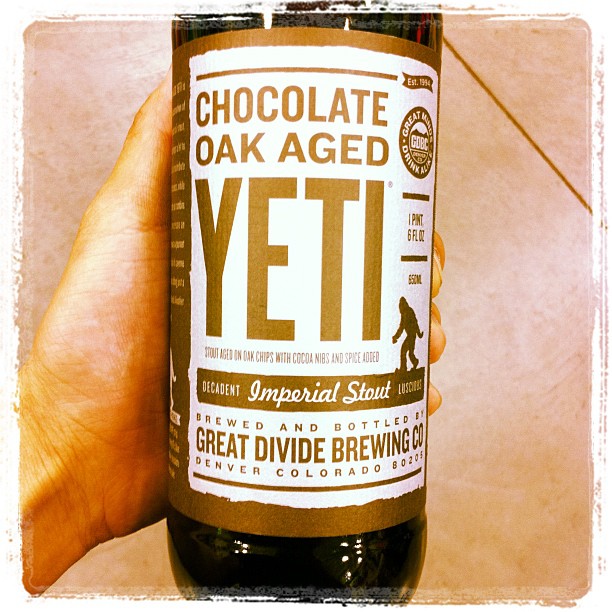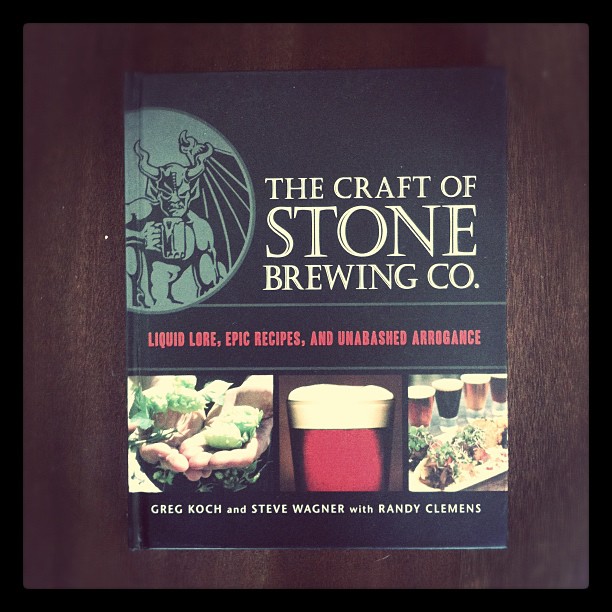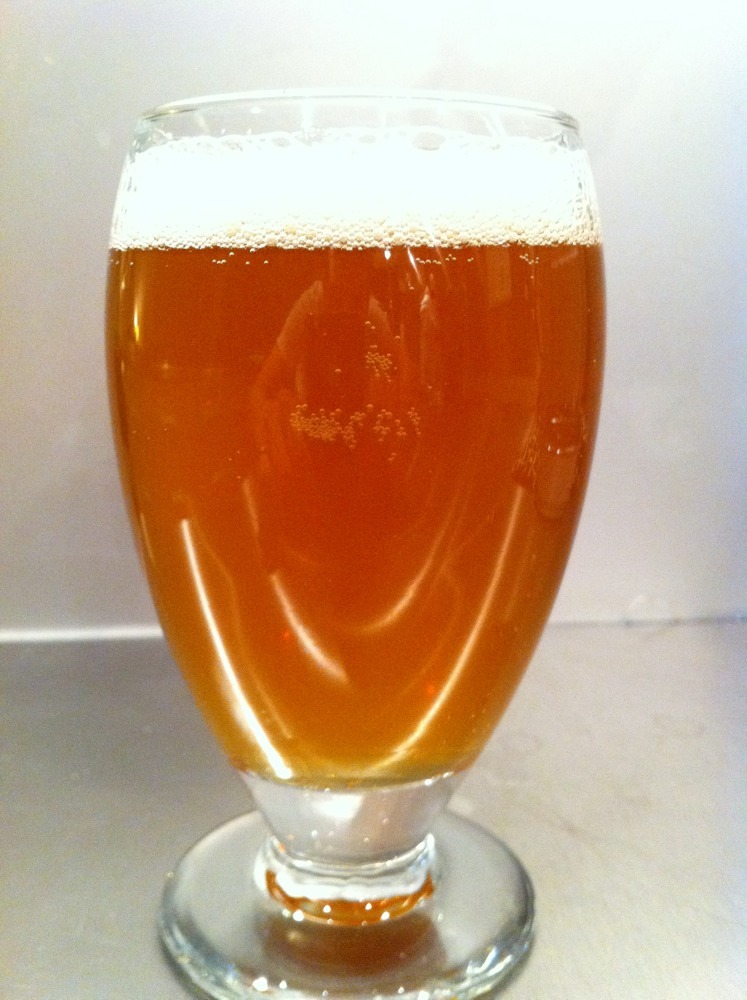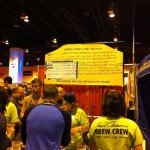This past summer Dogfish Head made its first gluten-free beer, Tweason’Ale. The beer was a huge success in its Rehoboth Beach Brewpub so Dogfish is planning on releasing four-packs of the bottled beer.
Like nearly every gluten-free beer, Tweason’Ale uses sorghum as its base. To keep the beer from tasting as bland as most gluten-free beers though, the beer also includes buckwheat honey and fresh strawberries.
I know what you are thinking, strawberry, honey beer sounds terrible. Like the sugary malt beverages made by Bacardi or something similar. Having tasted this beer at GABF, I can tell you that it isn’t what it sounds like.
First of all, natural sugars, like honey and fruit, are highly fermentable, leaving very little residual sugar. Despite having over a pound of strawberries per gallon, the beer is not bright red. It is a pale orange color, like most other beers. The taste is very refreshing, with a light, fruity finish. As I mentioned before, it is not a sugary, sweet beer. It is however very light bodied, with a slight tanginess from the fermented fruit.
With how much fruit is in this beer, I can’t imagine that this is an easy beer to make a lot of so it is very likely to be difficult to find this December. No announcement has been made as to which markets this will be distributed to.
For more info, and some moving pictures of the creation process, see Dogfish Head’s website: http://www.dogfish.com/tweasonale
Left Hand is a Colorado brewery that I have heard of various times. Previously, I had never tasted anything of theirs since they don’t distribute to Nevada. The one beer that I have consistently heard of is their Milk Stout.
What is a milk stout? It is a stout with lactose added. Lactose is a sugar that comes from milk. Lactose is not fermentable, meaning any lactose that is added when brewing will not get converted into alcohol and instead remains in the final beer adding more body and residual sweetness. Left Hand assures it’s customers that “milk sugar in your stout, is like cream in your coffee.”
This past Friday, Left Hand had a press event, that was prefaced by mysterious magazine ads, announcing the release of Milk Stout Nitro in bottles. They are the first craft brewer to bottle a beer using nitrogen gas. What this all means: Beer is normally carbonated using carbon dioxide (CO2) as this is a byproduct of fermentation. However, many brewers will force carbonate their beers with a blend of CO2 and nitrogen gas (N2) (typically just called “nitro”) because it gives the beer a smoother softer carbonation than just pure CO2. This is typically only done with stouts or porters as this primarily complements these styles. While nitro stouts feel and taste better than CO2, the problem is that N2 gas does not mix in the beer as easily. Special nitro taps are installed in bars that have the proper pressure to hold the gas in the beer. However, nitro beers cannot be used in growler fills because the gas dissipates too quickly, the beer must be served fresh. Which means bottling nitro beers was not possible for a long time. Guinness, the most famous beer served on nitro, developed what’s called a widget that contains N2 gas and is inserted into the bottles at bottling time. Once the bottle is opened and poured into a glass, the widget forces N2 gas into the beer allowing nitro beers to be enjoyed at home. Young’s Double Chocolate Stout is another common beer that is bottled with nitro widgets.
Back to Left Hand: Milk Stout was always available on nitro tap but the bottled version used CO2. In planning to bottle Milk Stout using nitro, Left Hand did not want to use a widget. They spent over two years and hundreds of thousands of dollars developing a way to bottle nitro beer without a widget. They are choosing to keep the secret to themselves rather than risk patenting the process and it becoming public knowledge. The result is amazing. I tasted this beer at GABF and was very impressed. I would happily drink this over any other stout, yes even Guinness. There is no “milky” taste, only a very balanced, smooth stout that is neither too bitter and roasted or too sweet. It’s perfect. Life was much easier having never tasted this beer, I didn’t know what I was missing. I am now forever longing for the day that this beer becomes available in Las Vegas.

*Photo credit: Left Hand Brewing Company
Last night, Greg Koch posted the above photo along with the caption “I predict a Crime will happen this week. I also expect Punishment. #crimeandpunishment”
Let me use this as an opportunity to talk about some of my favorite beers: In 1997, Stone released Arrogant Bastard, an aggressively bitter, malty beer. To celebrate the one year anniversary release of Arrogant Bastard, Stone released Double Bastard, an angrier version of Arrogant Bastard. Stone later released OAKED Arrogant Bastard in 2004, a version of Arrogant Bastard with oak chips added to smooth out some of the harshness. Finally, in 2010, Stone released Lukcy Basartd as a celebration of the 13th anniversary of Arrogant Bastard. Lukcy Basartd is a mix of all 3 of the Bastard beers.
Not content with the aggressiveness of these beers, Stone created two more beers earlier this year using these beers as a base: Crime and Punishment. Crime: Double dry-hopped Lukcy Basartd, meaning even more hops are added after fermentation, aged in an oak barrel with chili peppers added. Punishment: Double Bastard aged in an oak barrel with chili peppers added. Punishment is obviously the spicier/angrier version of the two. Double Bastard is a far bitterer beer than the rest and adding peppers only makes it burn more.
As awesome as these beers are, they are hard to find. When they were last brewed, the kegs were available at various special events and festivals held by Stone. Crime was in Las Vegas earlier this year at Aces and Ales so I had a chance to try it there. It’s likely that these new batches will be used again for special events or as part of Stone’s specialty bottled line: Quingenti Millilitre, which are currently difficult to get a hold of as well.
Few people can handle drinking any of the Bastard beers, and even fewer can handle Crime and Punishment, but if you ever get the opportunity, I highly recommend at least trying these out, just for the experience!
This past weekend was the Great American Beer Fest in Denver, CO. I was lucky enough to have visited the final evening of the festival.
By far, the best beer fest I’ve been to, obviously, since this the biggest in the country. I finally had the chance to taste so many different beers that I don’t have access to in Nevada. In future posts I’ll write about some specific breweries or beers I tasted.
Downside of visiting the final day, a lot of the more rare beers were already out. However I do have a list of favorites that I did get to try:
Stone BELGO Old Guardian Barley Wine
Rogue Old Crustacean Barley Wine
Dogfish Head Tweason’ale
Ballast Point Victory at Sea
Left Hand Milk Stout
Great Divide Chocolate Oak Aged Yeti and Espresso Oak Aged Yeti
Alaskan Smoke Porter aged since 2000
And the list goes on. Attached are a few pictures I was able to take. Yes I took a picture in front of the Anheuser Busch booth for fun, no I didn’t try anything there. I was surprised to see how busy the booth was, which is a shame considering all the great craft breweries that were there in attendance.
Got to meet Zane Lamprey from the TV shows Three Sheets and Drinking Made Easy, super nice guy. Also saw Greg Koch from Stone, he insisted that a picture be taken with him.
All in all, it was a great time. I highly recommend you take a trip to Denver for future GABF’s. It is impossible to not have fun.




First, some history
The original: I brewed a pale ale for my first beer. I wanted to try and make a beer as simple as possible but with as much flavor as possible. Pale malt, centennial hops. Thats it. The result was good, however very one dimensional.
The new: I wanted the beer to have a more complex flavor, while still keeping the ingredients simple. First, I added honey. Not too much honey, not enough to taste it but enough to add to the flavor. Second, I rearranged the hop additions. The measured bitterness between the two was the same (~40 IBUs) however more was shifted earlier in the boil, giving the beer additional bitterness. Also, I added over 5 times as much hops after the boil, adding hop flavor (not bitterness) and aroma.
The result: The flavor has completely changed. Rather than a plain bready body and yeasty aroma, there is a rich citrusy smell and a sweet complex flavor. The bitterness still falls within the pale ale range, nowhere near the range of my IPA, but acceptable.
I bottles this last week. Really, I should be waiting 2-3 weeks to drink it but I couldn’t wait. The result was carbonation that dissolved away too quickly. The next 2 weeks will condition the beer to hold onto the carbonation better.
I’m very excited for this beer.













